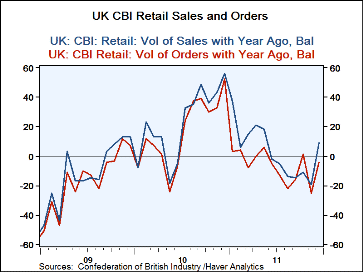 Global| Dec 21 2011
Global| Dec 21 2011UK Distributive Trades Index in Upside Surprise
Summary
The UK retail index rose to a +9 in December after posting a -19 in November. Sales have been expected to slip as sales for this ‘time of year’ were projected at a -36. Orders also ‘improved’ to a -4 from a -25 result back in [...]
 The UK retail index rose to a +9 in December after posting a -19 in November. Sales have been expected to slip as sales for this ‘time of year’ were projected at a -36. Orders also ‘improved’ to a -4 from a -25 result back in November. That is orders were slipping but not as badly as they had been slipping. Such is the lexicon of the ‘Net’ readings in this survey. Still, stocks are higher at +10 up from +8 in November. Despite the reading that sales are better inventories are still moving higher.
The UK retail index rose to a +9 in December after posting a -19 in November. Sales have been expected to slip as sales for this ‘time of year’ were projected at a -36. Orders also ‘improved’ to a -4 from a -25 result back in November. That is orders were slipping but not as badly as they had been slipping. Such is the lexicon of the ‘Net’ readings in this survey. Still, stocks are higher at +10 up from +8 in November. Despite the reading that sales are better inventories are still moving higher.
Looking ahead the outlook for January has sales at -18 compared to a year ago implying that retail respondents are treating the monthly +9 as a one-off result. Orders over one year ago are projected at a -8 which is much better than what had been mooted for December. Sales for the ‘time of year’ are still put at a -27 which is better than the -36 which had been set out for December but still worse than the -19 that had been projected for November.
On balance there is some unexpected good news but it does not seem to have affected the outlook or perceptions of current economic strength by very much.
The percentile readings for the current barometers are weak but the standings for the expected variables looking into January are generally as bad - or lower than their values in December. For now, we evaluate this unexpected good news as an anomaly and wait for a reassessment next month. Of course, all the dallying in Europe and the sniping back and forth between EMU members and the UK make it prudent to see risk as still lingering and to be skeptical about good news when it shows its face.
| UK Retail volume data CBI Survey | |||||||||
|---|---|---|---|---|---|---|---|---|---|
| Reported: | Jan 12 |
Dec 11 |
Nov 11 |
Oct 11 |
12Mo Avg |
Pcntle | Max | Min | Range |
| Sales/Yr Ago | - | 9 | -19 | -11 | 3 | 57% | 57 | -55 | 112 |
| Orders/Yr Ago | - | -4 | -25 | 1 | -7 | 49% | 52 | -58 | 110 |
| Sales: Time/Yr | - | -16 | -39 | -34 | -21 | 37% | 41 | -50 | 91 |
| Stocks:Sales | - | 10 | 8 | 15 | 19 | 32% | 31 | 0 | 31 |
| Expected: | Jan-12 | ||||||||
| Sales/Yr Ago | -18 | -6 | 4 | -14 | 0 | 31% | 56 | -52 | 108 |
| Orders/Yr Ago | -8 | -18 | -3 | -19 | -8 | 48% | 41 | -53 | 94 |
| Sales: Time/Yr | -27 | -36 | -19 | -26 | -20 | 29% | 31 | -51 | 82 |
| Stocks:Sales | 7 | 7 | 12 | 14 | 14 | 27% | 26 | 0 | 26 |
| Since Sept 1989 | |||||||||
Robert Brusca
AuthorMore in Author Profile »Robert A. Brusca is Chief Economist of Fact and Opinion Economics, a consulting firm he founded in Manhattan. He has been an economist on Wall Street for over 25 years. He has visited central banking and large institutional clients in over 30 countries in his career as an economist. Mr. Brusca was a Divisional Research Chief at the Federal Reserve Bank of NY (Chief of the International Financial markets Division), a Fed Watcher at Irving Trust and Chief Economist at Nikko Securities International. He is widely quoted and appears in various media. Mr. Brusca holds an MA and Ph.D. in economics from Michigan State University and a BA in Economics from the University of Michigan. His research pursues his strong interests in non aligned policy economics as well as international economics. FAO Economics’ research targets investors to assist them in making better investment decisions in stocks, bonds and in a variety of international assets. The company does not manage money and has no conflicts in giving economic advice.






